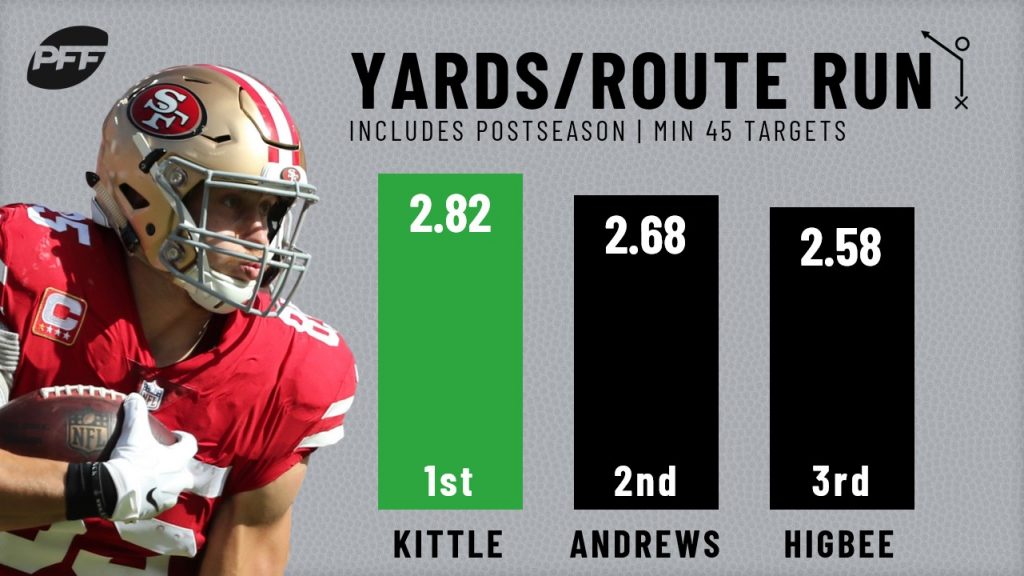PFF's in-depth charting and advanced stats look beyond the box score to identify key metrics otherwise overlooked across all positions in the NFL. This “Signature Stat Spotlight” series will walk readers through the varying advanced stats and metrics we track for every player at every position in every game.
Continuing the Signature Stat Spotlight series, we take on tight ends and the advanced stats that play into evaluating pass-catchers at the NFL and FBS level.
[Editor’s Note: To dive into PFF’s grading system and Premium Stats 2.0, subscribe to PFF’s ELITE – Monthly or ELITE – Annual subscription.]
Yards per route run is the crown jewel of PFF’s advanced stats for wide receivers and tight ends. Dividing total receiving yards recorded by the number of routes run in a given game, season, career, etc. provides a great one-number summary of just how efficient a receiver is on a down-by-down basis. Receivers need to create separation, earn targets, secure passes and generate yards after the catch to have a high yards per route run figure, making it a product of multiple factors and, as a result, a fantastic advanced stat made available to all of PFF’s ELITE subscribers.
In addition to yards per route run, PFF tracks passer rating when targeted, drop rate, deep receiving statistics and slot production in Premium Stats 2.0. Outside of ELITE, PFF also charts contested targets, receptions, etc. and forced missed tackles and yards after contact on receptions.
PFF's ELITE subscription also offers run-blocking and pass-blocking grades for tight ends in Premium Stats 2.0.
Signature Stat Spotlight Series:
QB | RB | WR | TE | OL | DL | LB | CB | S
Yards per Route Run
Not only was George Kittle (94.3) the highest-graded tight end in football in 2019, but the San Francisco 49ers phenom was also the league’s highest-graded overall player with at least 400 primary (offense or defense) snaps played. He also led all qualifiers at his position in yards per route run (2.86) and PFF receiving grade (94.2) while catching 93-of-117 targets for 1,124 for 53 first downs and five touchdowns.

Baltimore Ravens second-year tight end Mark Andrews ranked second behind Kittle in yards per route run (2.68) and Los Angeles Rams’ Tyler Higbee finished third (2.58). Cleveland Browns’ Demetrius Harris ranked last in yards per route run (0.66) among the 41 NFL tight ends with 200 or more routes run on the year.
Passer Rating when Targeted
Among the 20 NFL tight ends with 50-plus targets in 2019, New Orleans Saints’ Jared Cook ranked first in passer rating when targeted (142.4). The veteran tight end hauled in 48-of-67 targets for 759 yards, 27 first downs and nine touchdowns in his first year with Drew Brees & Co. Minnesota Vikings’ Kyle Rudolph (136.7) and Houston Texans’ Darren Fells (127.8) ranked second and third, respectively.
Indianapolis Colts veteran tight end Eric Ebron finished the 2019 season ranked last among the same group of qualifying tight ends in passer rating when targeted at 80.0. He caught just 31 passes from 50 targets for 375 yards, 17 first downs and three touchdowns.
Deep Receiving Performance
Only seven NFL tight ends recorded 10 or more deep – 20-plus air yards – targets in 2019. Kansas City Chiefs’ Travis Kelce led all at the position in deep receiving yards with 274 this past season while Andrews finished second at 224.
| Name | Team | Deep Targets | Deep Receptions | Deep Receiving Yards | Deep Touchdowns |
| Travis Kelce | Chiefs | 12 | 8 | 274 | 3 |
| Mark Andrews | Ravens | 18 | 8 | 224 | 4 |
| Darren Waller | Raiders | 12 | 5 | 160 | 0 |
| Dawson Knox | Bills | 10 | 5 | 160 | 0 |
| Jimmy Graham | Packers | 13 | 4 | 146 | 0 |
| O.J. Howard | Buccaneers | 10 | 5 | 141 | 0 |
| Mike Gesicki | Dolphins | 15 | 5 | 130 | 2 |
Slot Receiving Performance
Andrews also led all NFL tight ends with at least 100 routes from the slot in yards per route run (3.33). He recorded 51 receptions from 71 targets for 731 yards, 29 first downs and five touchdowns across his 221 routes run from the slot in 2019.
| Name | Team | Slot Routes Run | Slot Targets | Slot Receptions | Slot Yards | Slot Touchdowns | Slot YPRR | Slot Passer Rating when Targeted |
| Mark Andrews | Ravens | 221 | 72 | 51 | 737 | 5 | 3.33 | 109.5 |
| George Kittle | 49ers | 104 | 38 | 33 | 319 | 2 | 3.07 | 108.2 |
| Travis Kelce | Chiefs | 232 | 52 | 41 | 480 | 2 | 2.07 | 117.9 |
| Jared Cook | Saints | 253 | 43 | 30 | 482 | 5 | 1.91 | 136 |
| Darren Waller | Raiders | 163 | 42 | 29 | 308 | 1 | 1.89 | 88.2 |
Rookies Noah Fant and Irv Smith Jr. both struggled to produce at a high level from the slot in 2019. Fant ranked last among qualifiers in slot yards per route run at 0.28, and Smith wasn’t much better at 0.51.
Drop Rate
Kittle dropped just one of his 86 catchable targets and ranked first among tight ends with at least 40 catchable targets in drop rate (1.2%) as a result. Former Carolina Panthers tight end Greg Olsen finished second at 1.9%, as he dropped just one of his 53 catchable targets in 2019.
Cook had the highest drop rate (10.4%) of any NFL tight end with 40-plus catchable targets in 2019. He was also the only qualifying tight end with a drop rate above 10% a year ago.
Contested Targets/Catches
Atlanta Falcons’ Austin Hooper was fantastic in contested-catch situations a year ago. He caught 12-of-18 contested targets to lead all NFL tight ends in contested-catch percentage at 66.7%. Los Angeles Chargers’ Hunter Henry was the only other tight end with 10-plus contested targets and a contested-catch percentage above 60%.
Detroit Lions rookie T.J. Hockenson recorded the lowest contested-catch percentage of any qualifying tight end in 2019. The former Iowa product caught just five of his 17 contested targets a year ago.
Yards After Contact per Reception/Forced Missed Tackles
Among the 22 NFL tight ends with at least 40 receptions in 2019, Fant ranked first in yards after the catch per reception at 8.28. Tennessee Titans’ Jonnu Smith (7.54) ranked second and Kittle ranked third (7.26). Cincinnati Bengals’ Tyler Eifert recorded the lowest average of the group 2.63 in 2019.
Run-Blocking/Pass-Blocking Grades
Arizona Cardinals veteran tight end Maxx Williams led all qualifiers at his position in PFF run-blocking grade (84.7) in 2019. He was also the only NFL tight end with 300-plus offensive snaps played that earned a PFF run-blocking grade above 80.0. Cook earned the lowest PFF run-blocking grade (41.7) among qualifying tight ends.
In pass protection, Jacksonville Jaguars’ Nick O’Leary was the league’s best. He ranked first among qualifying tight ends in PFF pass-blocking grade (87.5) and allowed zero pressures across his 31 pass-blocking snaps. Fant earned the second-lowest run-blocking grade (45.4) and the lowest PFF pass-blocking grade (26.5) of any qualifying NFL tight end in 2019.
To continue to learn more about PFF’s advanced stats, subscribe to PFF’s ELITE subscription to dive into the numbers yourself throughout the offseason and into next season.
Signature Stat Spotlight Series:



 © 2024 PFF - all rights reserved.
© 2024 PFF - all rights reserved.